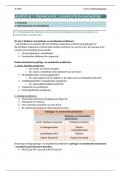Summary
Rejecting minorities/Understanding prejudice samenvatting artikelen
- Module
- Institution
Ik heb een samenvatting gemaakt van alle artikelen die voor het vak in het jaar 2022/2023 opgegeven waren als tentamenstof. Vak is hernoemd naar Understanding Prejudice maar nog steeds hetzelfde vak, Samenvatting is gedetailleerd, heb er zelf destijds iets van een 8.5 mee gehaald Ellemers, N., & ...
[Show more]












